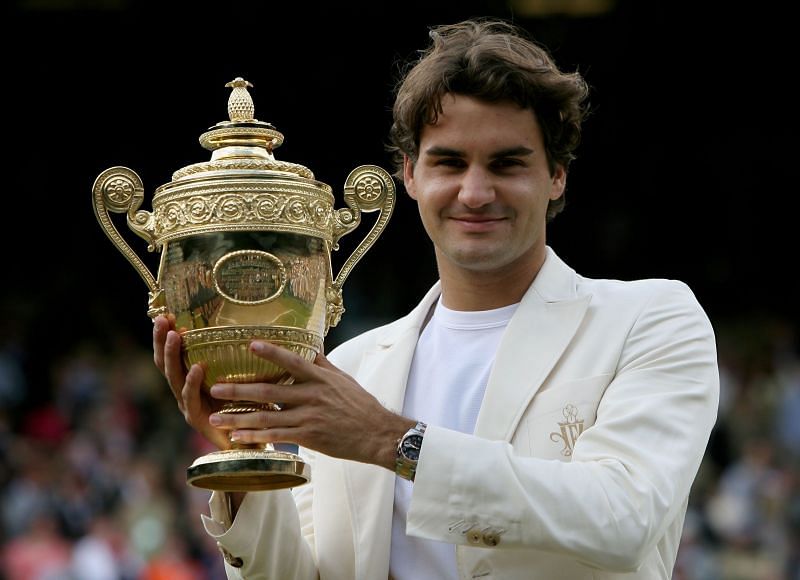
Holds and Breaks – How Roger Federer "created a monster" from 2004 to 2007
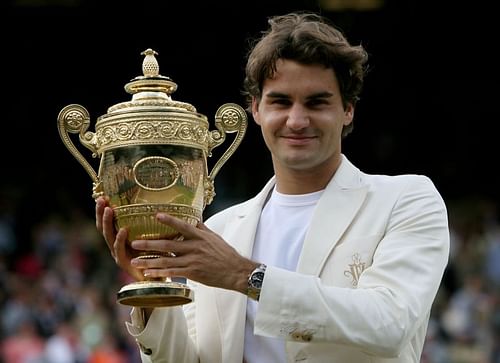
In tennis, the importance of holding serve - or breaking serve - can never be overstated. No matter how well you may play off the ground, or how many magical trick shots you pull off, if you don't hold and break serve more often than your opponent, you are unlikely to win.
Against that background, we are taking an analytical look at various tennis phenomena through the statistical lens of holds and breaks. And here, we are focusing at a period of unprecedented dominance by a single male player.
The reign of Roger Federer
Between the years of 2004-2007, one man, Roger Federer, ruled over the men’s game in a way that hasn't been seen before or since. His domination was so utter and so complete (outside of a certain bogey of Rafael Nadal on clay, which incidentally is another phenomenon that have taken a closer look at in this series) that when an ailing Federer lost in the semifinals of the 2008 Australian Open, it sent the entire world into a frenzy.
“I’ve created a monster,” the bemused Swiss remarked at the time, and it was hard to disagree.
There are several peculiarities that make Roger Federer’s “monster” stand out. One of the most striking aspects of his reign was that even the very best players in the world were hardly faring any better against him than the lower tier players.
Federer wasn't just beating the other top players; he was beating them while barely breaking a sweat.
Winning a set against him was a big deal. From 2004-07, he won 11 of the 12 Grand Slams outside of the French Open. In those 11 finals, he lost an aggregate of just seven sets. There was also an extraordinary four bagels in those 11 matches, including the only multiple bagel in men’s Grand Slam final history - in his 6-0 7-6 6-0 demolition of Lleyton Hewitt at the 2004 US Open.
To put that in perspective, there was only one bagel – at the 2015 Australian Open final – in all Grand Slam finals throughout the 2010s.
The numbers
When we look at the absolute greatest players of all time, many of them stand out for having either a great serve or a great return. Roger Federer is arguably the only player in tennis history to have both one of the greatest serves and one of the greatest returns that the game has seen.
Federer’s serve is one of the best first strikes any player can hope to have, and his return has often set him up very well to take the first strike in the rally. Perhaps this ability to take the opponent’s strengths partially out of the equation was a major contributing factor in his dominance.
Holds
First, let’s talk about his serve. The lethality of Roger Federer's serve, as well as the serve+1 combination, is obvious. No matter who you are, you would have a tough time breaking the Federer serve. The Swiss has always had the ability to keep holding serve, even against the best of returners.
With 88.82% of service games won throughout his career, Federer is fifth on the list of all-time service games won percentage. Below is the top 10.
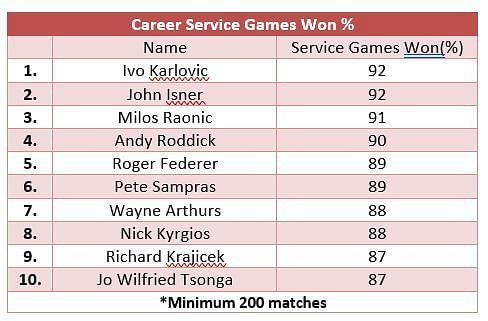
From 2004-07, this percentage was further up at 90%.
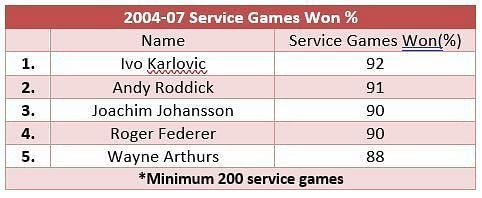
The truly scary part is that even against top 10 players, Federer was holding almost as comfortably.
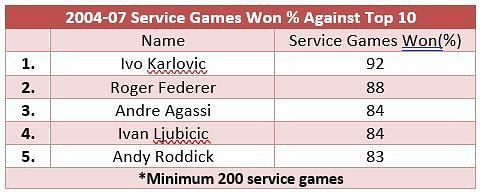
It is expected that you’ll have a tougher time holding against the very best players. And this is where Roger Federer really stood out. He was well clear of everyone except Ivo Karlovic against the cream of men’s tennis.
And while the Swiss was clearly the second best player on clay during this period, his dominance on serve outside of clay is even more absolute. Outside clay, Federer was 5.11% clear of third-placed Ivan Ljubicic, with 90.25% service holds against top 10 opponents.
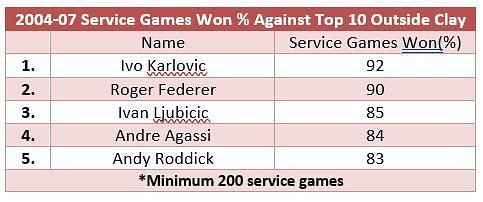
In short, breaking the Federer serve was an absolute nightmare for even the very best players in the world during that incredible 2004-2007 period.
Breaks
While Roger Federer keeps breezing through his service games, his opponents often struggle to hold serve against him. From 2004-07, almost every service game against Federer seemed an uphill struggle - even for the likes of Andy Roddick.
The Swiss never took big cuts at the return like an Andre Agassi or a Novak Djokovic. Instead, he returned from very close to the baseline, never giving up ground. And his chipped and blocked returns are renowned for neutralizing any serve.
If we look at overall return games won percentages, Federer is ninth, winning 30.44% of his return games from 2004-07.
But perhaps the biggest strength of Federer’s return is how easily he can return the biggest serves on tour. It would be very interesting to sort return numbers against only the biggest servers on tour, but that is a logistically difficult and overly subjective task. What we can find, instead, are return numbers against the best players on tour.
When we take a look at career return games winning percentage against top 10 players, Roger Federer is 15th on the all-time list with 22.29%.
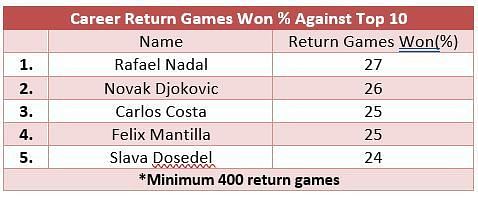
The above table is filled with players who are very adept at rallying from negative positions, a trait which helps in getting a lot of breaks on clay. For example, Nadal’s career return games won percentage against top 10 players is 26.95%. But outside of clay, it drops to 19.91%.
Of course, clay is a surface where there is always a higher number of breaks compared to other surfaces. And your ability to break there is more dependent on your ability to rally from negative positions on the court than on your return itself.
But interestingly, Roger Federer’s career return games winning percentage against top 10 opposition is 22% both on clay and outside of clay. Over the course of his whole career, he is No. 5 on the list of return games winning percentage against top 10 opposition outside clay.
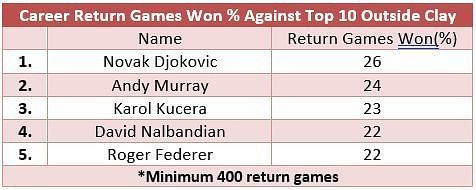
But from 2004-07, Federer was breaking in 27.28% of his return games against top 10 opposition on all surfaces. That places him third, marginally behind David Ferrer and Rafael Nadal.
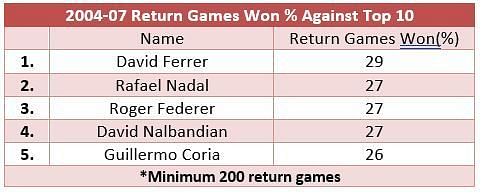
Outside of clay, Federer broke his top 10 opponents more than anyone else - with a return games winning percentage of 28.26%.
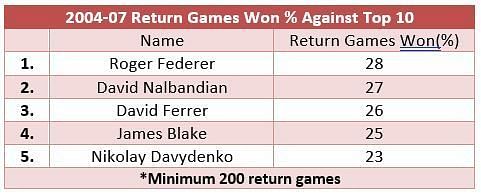
The upshot of it all is that from 2004-2007, against the very best players in the world, Roger Federer was holding serve more than everyone else except Ivo Karlovic. And he was also breaking serve more than everyone else outside of clay. With clay factored in, only Nadal and Ferrer were breaking serve more than him.
All this points to a massive uphill struggle for anyone facing Roger Federer during his best years of 2004-2007. It also goes a long way towards explaining his near-supernatural numbers of winning 315 out of 339 matches (93% of matches won) during that period.
After all, in a tennis match, if your opponent is superior at both holding and breaking serve, there’s really not much you can do.